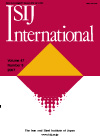54 巻, 1 号
選択された号の論文の38件中1~38を表示しています
- |<
- <
- 1
- >
- >|
Fundamentals of High Temperature Processes
Regular Article
-
原稿種別: Regular Article
2014 年 54 巻 1 号 p. 1-8
発行日: 2014/01/15
公開日: 2014/02/18
PDF形式でダウンロード (1117K) HTML形式で全画面表示 -
原稿種別: Regular Article
2014 年 54 巻 1 号 p. 9-18
発行日: 2014/01/15
公開日: 2014/02/18
PDF形式でダウンロード (1566K) HTML形式で全画面表示 -
原稿種別: Regular Article
2014 年 54 巻 1 号 p. 19-28
発行日: 2014/01/15
公開日: 2014/02/18
PDF形式でダウンロード (977K) HTML形式で全画面表示 -
原稿種別: Regular Article
2014 年 54 巻 1 号 p. 29-31
発行日: 2014/01/15
公開日: 2014/02/18
PDF形式でダウンロード (426K) HTML形式で全画面表示 -
原稿種別: Regular Article
2014 年 54 巻 1 号 p. 32-36
発行日: 2014/01/15
公開日: 2014/02/18
PDF形式でダウンロード (635K) HTML形式で全画面表示
Ironmaking
Regular Article
-
原稿種別: Regular Article
2014 年 54 巻 1 号 p. 37-42
発行日: 2014/01/15
公開日: 2014/02/18
PDF形式でダウンロード (780K) HTML形式で全画面表示 -
原稿種別: Regular Article
2014 年 54 巻 1 号 p. 43-48
発行日: 2014/01/15
公開日: 2014/02/18
PDF形式でダウンロード (960K) HTML形式で全画面表示 -
原稿種別: Regular Article
2014 年 54 巻 1 号 p. 49-55
発行日: 2014/01/15
公開日: 2014/02/18
PDF形式でダウンロード (1283K) HTML形式で全画面表示 -
原稿種別: Regular Article
2014 年 54 巻 1 号 p. 56-62
発行日: 2014/01/15
公開日: 2014/02/18
PDF形式でダウンロード (1653K) HTML形式で全画面表示 -
原稿種別: Regular Article
2014 年 54 巻 1 号 p. 63-71
発行日: 2014/01/15
公開日: 2014/02/18
PDF形式でダウンロード (951K) HTML形式で全画面表示
Steelmaking
Regular Article
-
原稿種別: Regular Article
2014 年 54 巻 1 号 p. 72-81
発行日: 2014/01/15
公開日: 2014/02/18
PDF形式でダウンロード (1569K) HTML形式で全画面表示 -
原稿種別: Regular Article
2014 年 54 巻 1 号 p. 82-86
発行日: 2014/01/15
公開日: 2014/02/18
PDF形式でダウンロード (1308K) HTML形式で全画面表示 -
原稿種別: Regular Article
2014 年 54 巻 1 号 p. 87-93
発行日: 2014/01/15
公開日: 2014/02/18
PDF形式でダウンロード (568K) HTML形式で全画面表示
Casting and Solidification
Regular Article
-
原稿種別: Regular Article
2014 年 54 巻 1 号 p. 94-102
発行日: 2014/01/15
公開日: 2014/02/18
PDF形式でダウンロード (5163K) HTML形式で全画面表示 -
原稿種別: Regular Article
2014 年 54 巻 1 号 p. 103-111
発行日: 2014/01/15
公開日: 2014/02/18
PDF形式でダウンロード (2421K) HTML形式で全画面表示
Instrumentation, Control and System Engineering
Regular Article
-
原稿種別: Regular Article
2014 年 54 巻 1 号 p. 112-118
発行日: 2014/01/15
公開日: 2014/02/18
PDF形式でダウンロード (1177K) HTML形式で全画面表示 -
原稿種別: Regular Article
2014 年 54 巻 1 号 p. 119-124
発行日: 2014/01/15
公開日: 2014/02/18
PDF形式でダウンロード (408K) HTML形式で全画面表示
Chemical and Physical Analysis
Regular Article
-
原稿種別: Regular Article
2014 年 54 巻 1 号 p. 125-130
発行日: 2014/01/15
公開日: 2014/02/18
PDF形式でダウンロード (1162K) HTML形式で全画面表示 -
原稿種別: Regular Article
2014 年 54 巻 1 号 p. 131-135
発行日: 2014/01/15
公開日: 2014/02/18
PDF形式でダウンロード (288K) HTML形式で全画面表示 -
原稿種別: Regular Article
2014 年 54 巻 1 号 p. 136-140
発行日: 2014/01/15
公開日: 2014/02/18
PDF形式でダウンロード (692K) HTML形式で全画面表示 -
原稿種別: Regular Article
2014 年 54 巻 1 号 p. 141-147
発行日: 2014/01/15
公開日: 2014/02/18
PDF形式でダウンロード (3865K) HTML形式で全画面表示 -
原稿種別: Regular Article
2014 年 54 巻 1 号 p. 148-152
発行日: 2014/01/15
公開日: 2014/02/18
PDF形式でダウンロード (853K) HTML形式で全画面表示 -
原稿種別: Regular Article
2014 年 54 巻 1 号 p. 153-159
発行日: 2014/01/15
公開日: 2014/02/18
PDF形式でダウンロード (1241K) HTML形式で全画面表示 -
原稿種別: Regular Article
2014 年 54 巻 1 号 p. 160-164
発行日: 2014/01/15
公開日: 2014/02/18
PDF形式でダウンロード (577K) HTML形式で全画面表示
Forming Processing and Thermomechanical Treatment
Regular Article
-
原稿種別: Regular Article
2014 年 54 巻 1 号 p. 165-170
発行日: 2014/01/15
公開日: 2014/02/18
PDF形式でダウンロード (1289K) HTML形式で全画面表示 -
原稿種別: Regular Article
2014 年 54 巻 1 号 p. 171-178
発行日: 2014/01/15
公開日: 2014/02/18
PDF形式でダウンロード (830K) HTML形式で全画面表示
Welding and Joining
Regular Article
-
原稿種別: Regular Article
2014 年 54 巻 1 号 p. 179-187
発行日: 2014/01/15
公開日: 2014/02/18
PDF形式でダウンロード (2171K) HTML形式で全画面表示 -
原稿種別: Regular Article
2014 年 54 巻 1 号 p. 188-192
発行日: 2014/01/15
公開日: 2014/02/18
PDF形式でダウンロード (1076K) HTML形式で全画面表示
Surface Treatment and Corrosion
Regular Article
-
原稿種別: Regular Article
2014 年 54 巻 1 号 p. 193-198
発行日: 2014/01/15
公開日: 2014/02/18
PDF形式でダウンロード (1658K) HTML形式で全画面表示 -
原稿種別: Regular Article
2014 年 54 巻 1 号 p. 199-205
発行日: 2014/01/15
公開日: 2014/02/18
PDF形式でダウンロード (1958K) HTML形式で全画面表示
Transformations and Microstructures
Regular Article
-
原稿種別: Regular Article
2014 年 54 巻 1 号 p. 206-211
発行日: 2014/01/15
公開日: 2014/02/18
PDF形式でダウンロード (659K) HTML形式で全画面表示 -
原稿種別: Regular Article
2014 年 54 巻 1 号 p. 212-221
発行日: 2014/01/15
公開日: 2014/02/18
PDF形式でダウンロード (1920K) HTML形式で全画面表示 -
原稿種別: Regular Article
2014 年 54 巻 1 号 p. 222-226
発行日: 2014/01/15
公開日: 2014/02/18
PDF形式でダウンロード (1220K) HTML形式で全画面表示 -
原稿種別: Regular Article
2014 年 54 巻 1 号 p. 227-234
発行日: 2014/01/15
公開日: 2014/02/18
PDF形式でダウンロード (991K) HTML形式で全画面表示
Note
-
原稿種別: Note
2014 年 54 巻 1 号 p. 248-250
発行日: 2014/01/15
公開日: 2014/02/18
PDF形式でダウンロード (350K) HTML形式で全画面表示
Mechanical Properties
Regular Article
-
原稿種別: Regular Article
2014 年 54 巻 1 号 p. 235-239
発行日: 2014/01/15
公開日: 2014/02/18
PDF形式でダウンロード (864K) HTML形式で全画面表示 -
原稿種別: Regular Article
2014 年 54 巻 1 号 p. 240-247
発行日: 2014/01/15
公開日: 2014/02/18
PDF形式でダウンロード (1973K) HTML形式で全画面表示
Erratum
-
2014 年 54 巻 1 号 p. 251
発行日: 2014年
公開日: 2014/02/18
PDF形式でダウンロード (435K)
- |<
- <
- 1
- >
- >|


